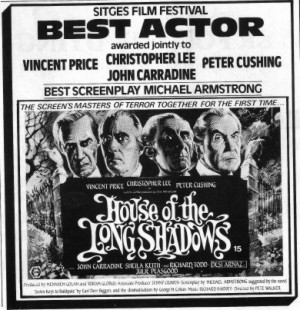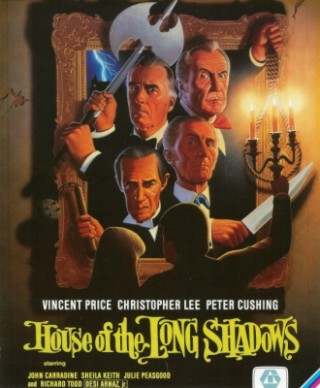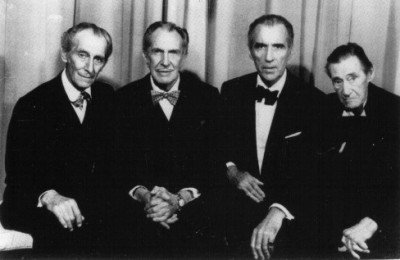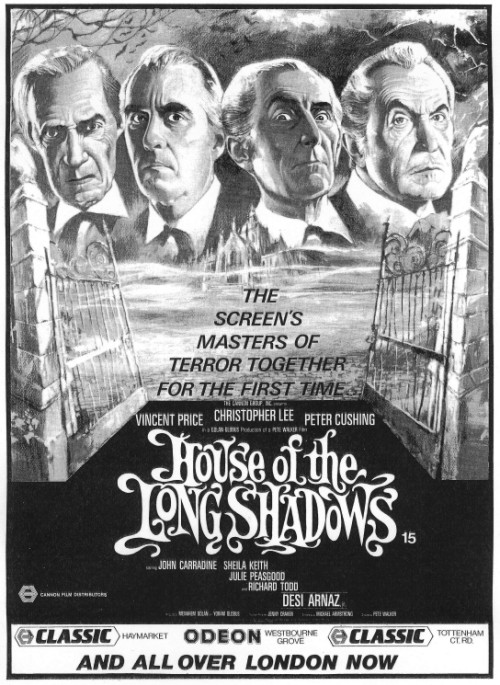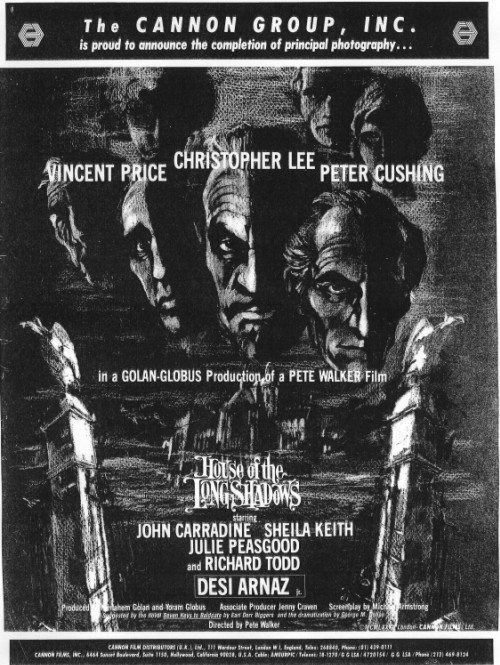House Of The Long Shadows -
History: Part 1
Made in 1982.
In the spring of 1982, Armstrong and the director, Pete Walker approached Cannon Films with Armstrong's supernatural thriller, Deliver Us From Evil. With his love of star packages, however, the head of Cannon, Menahem Golan was far more interested in them creating a project for cinema's horror legends: Vincent Price, Peter Cushing, Christopher Lee and John Carradine who had never, throughout their long film careers, actually appeared on screen together as a foursome. Golan felt that this would be a last opportunity to create cinematic history.
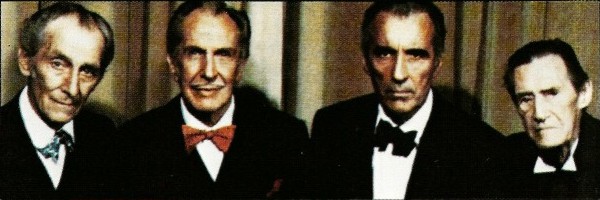
Walker and Armstrong knew that the current trend of teen slasher movies were not only unsuitable but would fail to attract these stars. There had been several attempts over the years to put them together in one film and each had failed because of the subject matter and the screenplay. Both Lee and Cushing, in particular, had often stated their dislike of the latest horror trends. Walker, therefore, suggested re-making an old classic, The Old Dark House but was unable to secure the rights from Universal.
Aware that if they failed to get back to Cannon quickly, they might lose the offer, Walker suggested another classic title of that era, Seven Keys To Baldpate.
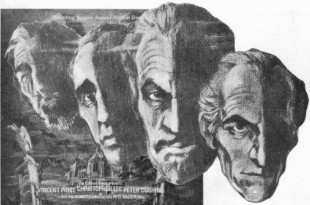
Seven Keys To Baldpate had started as a novel by the creator of Charlie Chan, E Digger Biggs and then been dramatised for the stage by George M Cohan. The play had become a long running hit on Broadway before being made into a silent, black and white film in 1917 directed by Hugh Ford and with George M Cohan as George Washington Magee. Hedda Hopper starred opposite him. In 1925, yet another black and white silent version was directed by Fred C Newmeyer, starring Douglas MacLean as the renamed William Magee and Edith Roberts as Mary Norton. The first sound version, also in black and white was directed by Reginald Barker in 1929 starring Richard Dix as William Magee and Miriam Seagar as Mary Norton. It had been re-made again in black and white in 1935, directed by William Hamilton and Edward Killy, with Gene Raymond as Mr Magee and Margaret Callahan as Mary Norton. Walter Brennan had also featured. In 1947, Lew Landers had directed a final version starring Phillip Terry as a renamed Kenneth Magee and Jacqueline White as a renamed Mary Jordan.
Walker laid on a screening of several versions at his flat for Armstrong and Jenny Craven, a friend of Armstrong and Golan, who would eventually act as associate producer on the film. (Golan also gave her the opportunity to produce the Agatha Christie thriller, Ordeal By Innocence, for Cannon a year later).
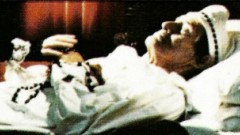
Armstrong recalls: "We ignored a 1916 version made in Australia and a TV version in 1946, neither of which seemed relevant or even connected to the book or the play, and watched - I can't remember how many versions - two or three, maybe - including the last one made in 1947. What we had hoped would be a Gothic mystery thriller along the lines of The Old Dark House turned out to be an extremely dated crime thriller and with nothing remotely suitable for our stars. Over dinner we decided the only thing we could do was to take the basic premise and the end twist and create a completely new story line to suit our needs. As I was going to be writing specifically for our four stars, it seemed logical to pay homage to the movies with which they had been most associated and create an affectionate tongue in cheek pastiche of Gothic movies incorporating as many genre movie references as possible. Certain that our stars would be drawn to the idea of parodying their own classic images, we became very excited, ordered some more wine and set about making a long list of everything we could think of from that classic era, - from thunderstorms and cats suddenly jumping out with a loud squeal to the inevitable “monster” behind a locked door, forever screaming heroines and menacing dialogues about ‘things better not spoken of...'."
To add one further frisson of excitement to their discussion, Walker suggested they also create a part for the original Bride Of Frankenstein, Elsa Lanchester.
Because of the urgency to cement the deal, Armstrong returned home that night and within twenty four hours had produced a detailed twenty page treatment so that Walker could fly off to LA and quickly secure his stars.
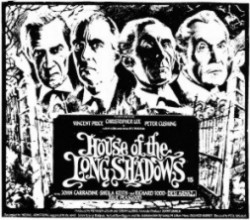
A few days later, Armstrong received a late night phone call from Walker telling him the stars liked the treatment and were interested, subject to the screenplay - which he had told them was on the point of completion and would be available for them to read within a fortnight.
"I've never been a slow writer but - to complete a screenplay within two weeks and be sufficiently polished to hook star names? It was quite ironic, really. The film was about a writer taking on a bet to write a Gothic novel within twenty-four hours. And here was I now agreeing to write a Gothic screenplay within two weeks! So, I locked myself away with my typewriter, reams of paper, an ample supply of whisky, enough cartons of cigarettes to open up a tobacconist's shop - in those days I was smoking around 120 a day! - and with Verdi's La Forza [Guiseppe Verdi's opera, La Forza del Destino (The Force of Destiny)] drowning out any distracting noises from the outside world, I sat down and went to work."
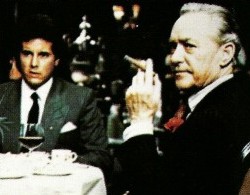
As required, Armstrong delivered a completed draft of the screenplay on time, literally only a couple of hours before Walker had to leave for the airport.
"It was like some crazy suspense thriller," Armstrong says, "I finished the final page of the script around five, grabbed a cab to Morton's where Pete was waiting for me before catching his flight to LA. I got there, literally, minutes before he had to leave for the airport. I'd been working around the clock on whisky and cigarettes, had had no sleep for two nights, staggered into Morton's more dead than alive, thrust the manuscript of typed pages into his hand - the only copy in existence - he asked me if I fancied a drink, I told him I just wanted to go home and collapse, he said he'd call me and raced off to grab a cab - and that was it. He read the script on the plane, called me to say he liked it. A week later he told me the script had gone down well with the actors and they'd all agreed to do it - except Elsa Lanchester, who was unfortunately too fragile to travel."
The part Armstrong had written for her was that of a woman forever haunted by her past as a jilted bride (referencing her most famous role) and then impishly linking the love of the two Frankenstein monsters to one of the most famous unrequited passions of the screen, Scarlett O'Hara for Ashley Wilkes. The role, instead, went to a Pete Walker favourite, Sheila Keith, who produced a wonderfully comic performance - but without Lanchester, the aforementioned tongue-in-cheek references lost their relevance.
"Pete and I intended one of the fun levels of the movie to be its density of movie and literary allusions, sometimes double-edged, like Vinnie's death: on the one hand echoing his demise in Witchfinder General whilst, on the other, being a parody of Mickey Mouse chopping up the broomsticks in Fantasia," Armstrong explains. "Unfortunately, quite a few filmic references for the movie buffs got lost along the way. There were also some that weren't followed through. For instance, the two juve leads were written as a kind of Dick Powell and Fay Wray exchanging those sparring quick banter dialogues of the period. The young married couple they meet were written as a parody of their British counterparts, epitomised by Noel Coward and Gertrude Lawrence in Private Lives. Again, as with the Elsa Lanchester situation, these references got lost, partly because the style of subtle campery required in the playing didn't really suit the actors cast in those roles."
<< Introduction
History (Part 2) >>

House Of The Long Shadows -
History: Part 2
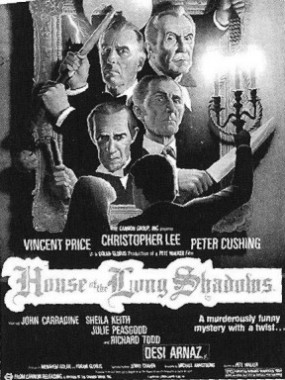
For once, Armstrong was not around for the casting. Jenny Craven, the associate producer, was elevated into overseeing the film from the moment it went into pre-production.
"Everything happened so quickly," Armstrong recalls, "Pete [Walker] had barely arrived back from LA before the picture was in pre-production with a shooting date only a few weeks away. To my concern, what I'd dashed off in those two weeks was the script they were working from. Admittedly my first drafts are usually as tight as most people's final drafts but, even so, I still desperately wanted, at the very least, to sit down and clean it up and tidy it - especially around the final confrontation scene between the Grisbane brothers - but it proved impossible. Pete had been swept up into the throes of production with Jenny [Craven], which meant that he and I couldn't find a free moment to get together and talk, even. Whenever I tried to say anything, everyone seemed so perfectly happy with the script as it was that I finally gave up pressing the point and assumed it was just me being insecure and finicky and that they'd come back to me if something wasn't working."
Within the first week of shooting a call came from the set, asking Armstrong to go down and fix the final dialogue scene between Vincent Price and Christopher Lee.
"I was so relieved," Armstrong confesses, "When I got on set, I found Christopher's concern was that he felt the final confrontation between he and Vinnie [Vincent Price] wasn't correctly balanced. Vinnie had more dialogue and had the last line. He was quite right, of course - except about wanting to have the last line. I sat down and tightened the whole scene, which I'd been dying to do. It automatically balanced their dialogue and resolved Christopher's worries and Vinnie still kept his last line, much to his amusement. From that point on, I decided it might be better if I remained on set for the rest of the shooting...although, as it turned out, there was nothing else that needed fixing."
Filming went smoothly. The stars, in particular, enjoyed working together and relished the camp theatricality of the dialogue and in lampooning the Gothic melodramas of the past. By the end of shooting, there was a general feeling on set that the end product would be a lot of fun and prove popular with audiences.
Leaving Walker to editing and post production, Armstrong became embroiled in Cannon's plans for publicity, part of which involved him writing and recording a series of jokey radio ads with Price and Lee.
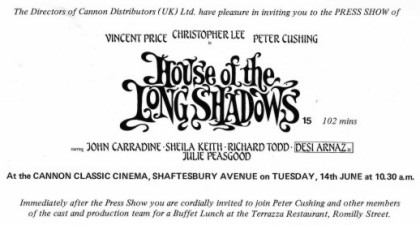
Elaborate plans were now in progress for releasing the film. Head of Distribution, Trevor Green and the publicity department came up with the idea of a starry, camp 30's style premiere to reflect the mood of the film. Craven, however, now overseeing the film's publicity machine, as well as the film, opposed the concept, preferring the idea of a simple dignified press reception instead. Shortly afterwards, Green left and joined his brother to build one of Britain's biggest current distributors, Entertainment.
As enthusiasm for a fun launch of the film waned and a more serious approach to its marketing was adopted, a similar sobriety seemed to be affecting the film during its post-production.
"Early in the cutting, Pete invited me into the editing suite to see his cut of the music scene and it was wonderful. Vinnie was very funny revelling in the moroseness of explaining the Grisbane's doom-ridden destiny to an accompaniment of Sheila Keith's wailing Verdi aria and the whole scene had a fabulous rhythm and stylish wit. Pete was so enthusiastic and clearly happy the way the film was turning out. I don't know what happened between then and later, when I saw the scene in the finished film, it had been re-cut and a good half of the scene was missing - mostly Vinnie's dialogue. There were other strange cuts and trims, too and a serious reduction of the comic pacing by dragging out Desi's [Arnaz Jr] early scenes and those with Julie [Peasgood]. Someone told me it was Cannon's attempt to tone down the film's sense of humour and turn it into a more serious horror film. How true that was I really don't know but somewhere along the way, I sensed Pete's usually buoyant spirit had been eroded by something. I don't know what. I don't know why."
It was Pete Walker's last film. Shortly afterwards he retired from the industry.
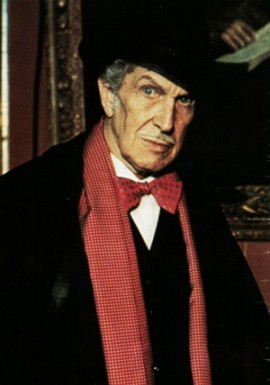
Armstrong's disappointment at the cuts in the final film was matched by the reaction of the stars. Price, in particular, was so upset that his role had been reduced by the cuts - especially in the music room scene - that he denounced the picture openly and refused to aid in its promotion or have anything more to do with it.
"I got a panic call from Cannon just before the film was due to open, telling me Vinnie's reaction and asking me if I could try and change his mind. Apparently he had refused to speak to anyone in the Cannon offices. He was staying at the Savoy in London because Coral [Price's wife, the actress Coral Browne] was receiving specialist treatment for cancer here. I called him and tried to persuade him to talk to Cannon but he was adamant. He was so angry and so very upset because he'd loved doing the film and thought it was some of his best comedy work and then to see so much of his performance cut...but what could I say? I was totally in agreement with him and, as I pointed out - the cuts to his dialogue were equally the cuts to my dialogue. We were on the phone over an hour and a half. By the end, we were commiserating with each other. He never did speak to anyone at Cannon, although he and I continued to stay in touch right up until his death."
The film opened in London in 1983 at the Carlton Cinema in the Haymarket to mixed reviews and a disastrous box office. Cannon's decision to sell it as a straightforward horror film had only resulted in confusing both the critics and audiences who, without having the benefit of knowing beforehand that it was meant to be a tongue-in-cheek lampoon of Gothic melodrama, mistook all the wit and pastiche jokes as an attempt at the real thing. Those critics, however, who did realise the film's intent, raved - in particular over the screenplay and the stars. Similarly the film went on to win prizes for Best Film, Best Screenplay and Best Actors (jointly for the four stars) at Avoriaz, Sitges, Paris and other genre festivals around the world.
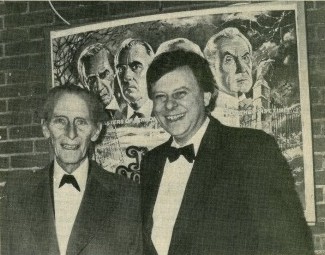
Dismayed at the film's London box office results, Armstrong persuaded Cannon to let him experiment with a different approach for the regions and sell the film as the comedy it was, rather than the horror film that it wasn't.
To test this, the East Anglian release was launched with a specially organised gala night audience in Stowmarket being issued with souvenir programmes quoting only those reviews recognising the film as a comedy. The result was a packed house loving the film, laughing and applauding throughout. As Armstrong points out, "It was exactly the same audience reaction we'd seen at Avoriaz and in Paris where it had won the audience prize for Best Film at the Paris Film Festival."
Despite this evidence of audience reaction, it was too late to change anything. Cannon's original marketing campaign remained and the film continued to fail at the UK box office. With a far more tongue-in-cheek marketing campaign the film fared better upon its American and international release, once more mainly garnering good reviews. Its excellent entry into the video market, however, was cut short by the collapse of Cannon. As part of the company's product sell-off, the film was included in a package acquired by MGM and, along with so much of the Cannon product seems to have been lost in the archives.
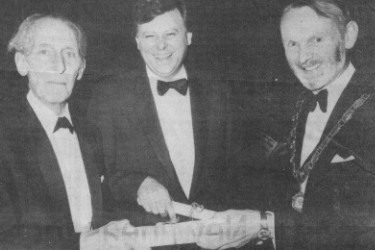
"The only problem with parody is that unless you know what is being parodied, you miss the joke and I think that's where certain people missed out on the film. I encountered the same problem when we staged The Curse Of Tittikhamon. Hardly any of the theatre critics knew the films being parodied so they took everything at its face value and missed the point completely. It's a pity because both Titti and House are so full of jokes for the movie buff - almost every single line of dialogue has a reference point to some movie or other - that I defy anyone to get them all in a single screening. Apart from the movie references, though, House Of The Long Shadows exists on several levels, which is why it really needs more than one viewing to appreciate it fully. It was also made with a great love for the films it so affectionately lampoons and as a swan song to the horror careers of the four. Just take a look at their dialogue to see what I mean. I firmly believe that when it does finally emerge on DVD, it will finally be recognised, not only as one of Pete's best and most complex films, but a fitting tribute and elegy to a bygone era."
<< History (Part 1)
Gallery >>
